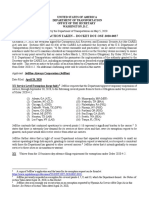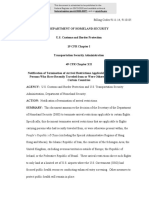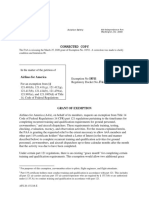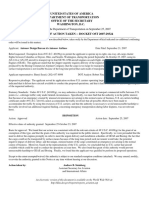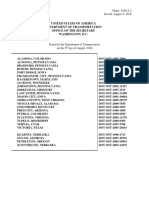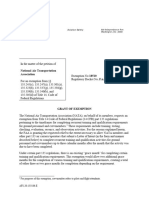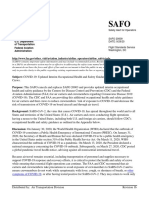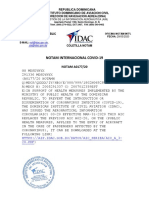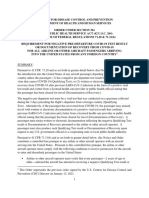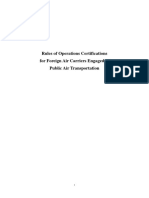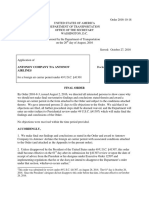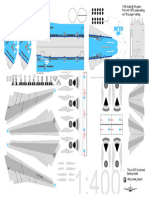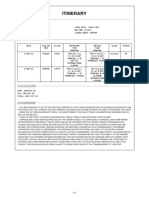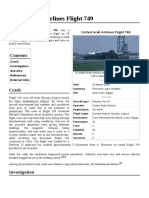Order 2023-5-6
UNITED STATES OF AMERICA
DEPARTMENT OF TRANSPORTATION
OFFICE OF THE SECRETARY
WASHINGTON, D.C.
Issued by the Department of Transportation
on the 3rd day of May, 2023
Served: May 3, 2023
In the matter of
14 CFR Part 213 Phase 2 Amendment of Order 2020-6-1
regarding:
Air China Limited d/b/a/ Air China; Beijing Docket DOT-OST-2020-0052
Capital Airlines Co., Ltd.; China Eastern Airlines
Corporation Limited; China Southern Airlines
Company Limited; Hainan Airlines Holding Co.
Ltd.; Sichuan Airlines Co., Ltd.; and Xiamen
Airlines
ORDER AMENDING 14 CFR PART 213 ORDER 2020-6-1
Summary
As discussed below, the U.S. Department of Transportation (the Department) is further
modifying the decision reached under 14 CFR Part 213 in Order 2020-6-1 to permit the
above-captioned combination carriers of China to operate, in the aggregate, a total of twelve
weekly round-trip scheduled passenger flights to and from the United States. This decision is
effective immediately.
Background
On June 3, 2020, the Department issued Order 2020-6-1, concluding that the Government of
China had, over the objections of the U.S. Government, impaired the operating rights of U.S.
carriers and denied U.S. air carriers the fair and equal opportunity to exercise their operating
1
�rights under the U.S.-China Civil Air Transport Agreement (the Agreement). 1 The Chinese
Government restrictions were embodied in a March 26, 2020 Notice issued by the Civil Aviation
Authority of China (CAAC). Accordingly, the Department issued Order 2020-6-1 to suspend all
Chinese carrier scheduled passenger air services between the United States and China, effective
as of June 16, 2020, or immediately upon affirmative approval by the President.
In a series of follow on actions, the Department amended Order 2020-6-1 to provide for
incremental increases in the aggregate total of U.S.-China frequencies that Chinese combination
carriers were permitted to operate. 2 These actions were each taken in response to CAAC
permitting similar aggregate increases in the U.S.-China services operated by U.S. combination
carriers, most recently to permit Chinese carriers to operate, in the aggregate, a total of eight
weekly round-trip passenger flights to and from the United States. CAAC subsequently
approved two weekly Dallas/Ft. Worth-Shanghai flights for American Airlines, Inc. (American)
for services beginning in November 2020, bringing the aggregate total of U.S. combination
services to ten.
Subsequent CAAC Announcement
On December 30, 2022, CAAC advised the Department by letter of its announcement dated
December 28, 2022, regarding “Measures for Resuming International Passenger Flights,”
whereby starting from January 8, 2023, both Chinese and foreign airlines could resume their
flights as per the Agreement, with the temporary restrictions on the number of international
passenger flights and limitation on passenger load factors lifted. Specifically, CAAC advised
that, as of January 8, carriers may resume all flights operated during the IATA Northern Winter
2019 traffic season, and may apply to add any additional flights during the Northern Summer
2023 traffic season which began on March 26, 2023. Certain restrictions, such as the allocation
of new slots, remain in place. Following the removal of China’s pandemic-related restrictions,
American began operating two additional weekly Dallas/Ft. Worth-Shanghai flights in March
2023, bringing the aggregate weekly total of permitted U.S. combination services to twelve.
Decision
We note that, although the CAAC’s December 28 announcement lifted certain COVID-related
restrictions it had imposed in the U.S.-China market, those restrictions had, and continue to have,
a devastating effect on the U.S.-China air transport market. For the past three years, CAAC has
unilaterally abridged the rights of U.S. carriers under the Agreement and the Chinese
Government has imposed other travel-related requirements that have severely disrupted the
market and depressed demand.
While the removal of restrictions by CAAC is a long-awaited positive step, in light of the
long-term harm to the market and the other factors noted above, we believe that the public
interest is best served by a balanced and incremental reopening to ensure an orderly
normalization of the U.S.-China air transport market and the overarching aviation relationship as
governed by the Agreement. To that end, we will continue to assess how and when to further
1
The Department fully set forth the basis for its conclusions in Order 2020-6-1, and before that in Order 2020-5-4.
2
See Orders 2020-6-3, 2020-6-6, and 2020-8-6.
�modify our Part 213 posture in a manner that offers an equitable and competitive operating
environment for our air carriers and provides for the “reasonable balance of rights and benefits
between both Parties” called for in the Agreement.
In light of the current state of the market and U.S. carrier services authorized by CAAC, we
therefore conclude that the public interest now requires a fourth modification, effective
immediately, of Order 2020-6-1, to now permit the Chinese carriers currently providing
scheduled passenger air services between the United States and China, in accordance with the
schedules that have been filed pursuant to Order 2020-5-4, to operate, in the aggregate, a total of
twelve weekly round-trip scheduled passenger flights to and from the United States. 3
As the Department stated in Order 2020-6-1, our overriding goal is an improved environment
wherein the carriers of both parties are able to exercise fully their bilateral rights to maintain a
competitive balance and fair and equal opportunity among U.S. and Chinese air carriers. While
the most recent change in CAAC posture has led us to increase to twelve weekly flights the U.S.-
China services that Chinese combination carriers may now conduct in the U.S.-China market, it
is clear that the long-term negative impact of the CAAC limitations over three years calls for an
incremental return to services in the U.S.-China combination services market as described above.
In that regard, we hope to maintain an ongoing and productive dialogue with CAAC with the
goal of a gradual, broader reopening of the U.S.-China air services market.
ACCORDINGLY,
1. We modify Order 2020-6-1 to permit, in the aggregate and subject to the limitations outlined
above, twelve weekly round-trip scheduled passenger operations to be operated by the Chinese
carriers currently operating scheduled combination service to the United States in accordance
with the schedules filed pursuant to Order 2020-5-4;
2. This Order is effective immediately;
3. We may amend, modify, or revoke this Order at any time and without hearing; and
4. We will serve this Order on Air China Limited d/b/a/ Air China; Beijing Capital Airlines Co.,
Ltd.; China Eastern Airlines Corporation Limited; China Southern Airlines Company Limited;
Hainan Airlines Holding Co. Ltd.; Sichuan Airlines Co., Ltd.; and Xiamen Airlines; all
certificated U.S. carriers operating large aircraft; the Embassy of the People’s Republic of China
in Washington, D.C.; the Civil Aviation Authority of China (CAAC); the Department of State;
3
By Orders 2020-6-12 and 2020-7-19, the Department disapproved all proposed schedules filed by the captioned
Chinese carriers, including on a prospective basis any schedules that may have been filed after the issuance of those
orders. We have decided in that regard, strictly to the extent necessary to permit operations by Chinese carriers
consistent with the terms of the present order, i.e., up to a maximum in the aggregate of four additional weekly
round-trip scheduled passenger flights to and from the United States under the terms prescribed herein, that the
Department will waive the 30-day advance filing requirement for schedules filed pursuant to Order 2020-5-4 and
will exempt those schedules, but only those schedules, from the terms of ordering paragraphs 1 and 2 of Order
2020-7-19.
�the Transportation Security Administration; and the Federal Aviation Administration.
By:
Carol A. (Annie) Petsonk
Assistant Secretary
Aviation and International Affairs
(SEAL)
An electronic version of this document is available on the World Wide Web at:
http://www.regulations.gov
